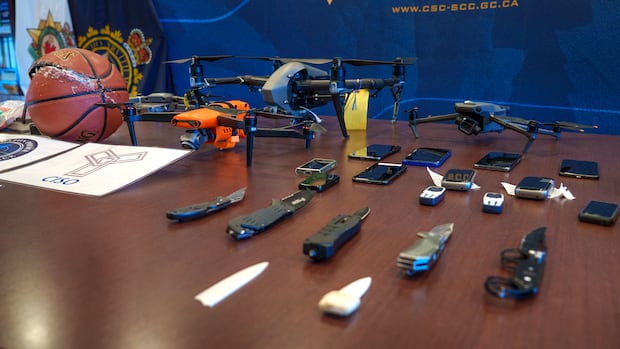Kingston police, corrections cracking down on drone smugglingA joint task force in Kingston has been targeting drones delivering contraband into prisons.A basketball packed with tobacco and cellphones sits on a table next to a drone equipped with a mechanism for dropping deep-sea fishing lures, repurposed to deliver contraband instead.Arranged around those items are piles of tightly wrapped packages reeking of pot, a handful of knives and more phones, each about the size of a thumb. The display represents just a fraction of the spoils seized by a pilot project targeting drone smuggling at prisons in Kingston, Ont.The display is a testament to the success of the program, but also evidence of the ever-evolving challenge facing police and corrections staff, as inmates and organized crime groups innovate new ways to smuggle drugs and weapons behind bars.For the past nine months, a joint task force made up of local police and correctional staff has been working on both sides of the prison walls to stop the flow of illegal goods and arrest those behind it.It’s the first team of its kind in Canada to specifically target drone smuggling this way.”Kingston is a prison town,” said Sgt. Jonas Bonham. “It just made sense for us to join forces and start doing it together.”Sgt. Jonas Bonham is head of the Kingston Police Intelligence Unit, which has been targeting drone smuggling at prisons around the city. (Felix Desroches/CBC)Bonham is head of the Kingston Police Intelligence Unit, which partnered with Correctional Service Canada (CSC) and the Canada Border Services Agency. He estimates they’ve managed to cut the number of local drone drops in half.”This task force, with its dedication to this specific issue, is making a huge difference,” agreed Joel Blacklock, a CSC senior project manager whose portfolio includes counter-drone technologies.Blacklock said drone smuggling started at Canadian prisons around 2016, then quickly took off, with 899 incidents reported across the country in 2023-2024, and 1,064 last year alone.With its four penitentiaries, Kingston quickly became a front line in the fight — particularly at the Collins Bay Institution.Located within the city, the prison known for its turrets, towers and bright red roof makes a tempting target.Just a short drive down the road is a busy grocery store parking lot Bonham described as the “original launch location” for much of the smuggling activity in Kingston.The Collins Bay Institution in Kingston has been a popular target for drone smugglers. (Felix Desroches/CBC)It may seem an unlikely launchpad until one considers what it offers: the chance to blend in while piloting from a parked car, access to a quick getaway and, of course, a straight shot to the prison.”This spot seems to fit the bill,” Bonham said. “We’ve caught a lot of people flying drones from this parking lot.”Smugglers set up lawn chairsBefore police began dialing in on these operations, the smugglers appeared to have made themselves quite comfortable.”They had lawn chairs set up on the roof of this plaza here, and they could fly right into the prison,” he said.Police describe this grocery store parking lot in Kingston as the ‘original launch location’ for much of the drone smuggling in the city. (Felix Desroches/CBC)Bonham remembers his first interception with a dose of humour.”We arrested them mid-launch,” he said. “Then we had to figure out how to land the drone with the package attached to it.”That was 2020, when the concept was still relatively new. But as drone smuggling became big business, law enforcement has been learning quickly, too.Contraband deliveries made to orderBonham and Blacklock said drones can be piloted from kilometres away, sometimes from the back seat of a moving car.Smugglers have disguised their packages with fake grass, wrapped them in white fabric to camouflage them in winter, and even tried to mimic sports equipment that might be found in a prison yard — like the basketball stuffed with contraband.A basketball, slit open then stuffed with tobacco and phones, is among the items police have seized. They say it likely would have been dropped in a prison yard where it would blend in with other sports equipment. (Felix Desroches/CBC)Blacklock said deliveries have even been made directly to cell windows, though CSC has since made infrastructure changes to prevent that.One novel approach comes from the world of deep-sea fishing. He said a release mechanism used by fishermen to drop their bait far from shore has been co-opted by smugglers to drop their payloads.Joel Blacklock is a senior project officer with Correctional Service Canada. Part of his role includes counter-drone technologies. (Felix Desroches/CBC)Bonham, the KPS officer, said cell phones are used to arrange each delivery from inside prison, with prices and specific goods negotiated and agreed upon in advance.”These things are ordered,” he said. “They hope it gets delivered. We hope we intercept it.”The task force is finding more weapons are being dropped. These include both ceramic blades that don’t register on metal detectors and traditional steel blades, according to Bonham.”It’s not like sharpening a toothbrush,” he said. “This is a pretty serious weapon and you could easily kill someone.”Gangs fighting over airspaceIn prison, the price of contraband is inflated by 10-25 times its street value. That includes substances that are illegal on the outside, Bonham explained.For example, according to a CSC news release issued after suspected drone drops earlier this month, staff seized tobacco, marijuana “shatter” and cellphones with an estimated institutional value of $338,745.Knives, tobacco and cellphones — some only the size of your thumb — are among the most popular contraband smuggled by drone. (Felix Desroches/CBC)Given the potential payoff, the risk of losing a drone worth $6,000-$10,000 is seen as a cost of doing business, said Bonham.With so much at stake, police are also starting to see a battle over the airspace near prisons.”Rival gangs [are] trying to control who can fly into prisons,” said Bonham. “The money that they’re making inside the prisons and pumping it back out into the street causes a lot of danger.”‘It’s like a bomb, almost’Lee Chapelle is well aware of that danger.He spent nearly 21 years in various Canadian prisons, mostly for break-ins and firearms offences. That included a stint at Collins Bay in the late 1980s.Today, Chapelle runs Canadian Prison Consulting Incorporated, using his experience to help first-time offenders and their families prepare for what being incarcerated is really like.Lee Chapelle, photographed here in 2016, runs Canadian Prison Consulting Incorporated and spent a number of years behind bars. (Chris Young/The Canadian Press)He’ll cop to being involved in some smuggling during his time behind bars, particularly small amounts of marijuana.In his day, smugglers would have to throw contraband over the fence or sneak it in by hiding it either on or inside their body, Chapelle explained.He said drones represent a huge leap forward, far beyond what he could have imagined.”It does sound synonymous with Uber or something along those lines,” he said of the made-to-order deliveries.The drone technology gives criminals the “mind-boggling” ability to smuggle in a much wider range of contraband in much larger amounts, according to the former inmate.”You’re talking anything from guns, phones, any illicit drug possible. Just when you think about the volume of things that can be brought in, that’s a scary thought,” he said. “It’s like a bomb, almost, ready to go off.”Change in charges reflects dangerThe sudden availability of drugs, weapons and phones also ratchets up the risk of inmates falling into debt and suffering violence inside prisons, explained Chapelle.”It would almost … feel similar to a war zone,” he said. “There is a legitimate need for corrections and for the police to step up their game to contend with the technological advances.”Smugglers tightly wrap packages of drugs, then tie the bundles to string and drop them behind prison walls from drones, according to investigators. (Felix Desroches/CBC)According to Bonham, police used to charge the drone smugglers with simple mischief. That’s been upgraded over the years to mischief endangering life, an acknowledgment of the impact the drugs and weapons are having on the inside.”We are suggesting that when you introduce contraband into an institution, it becomes currency,” explained Bonham. “That’s when violence comes in. It makes it very dangerous for staff, very dangerous for inmates.”As Kingston Police have become better at spotting and arresting drone smugglers, they’ve pursued suspects across the country and shared their knowledge with other police forces and correctional facilities along the way.Blacklock said the task force has proven to be an important tool in stemming the flow of contraband into Kingston’s prisons, and hopes other parts of the country can learn from its example.”We’re hoping that other law enforcement might be interested in following Kingston city police … and how they’re tackling our drone issues,” he said.
Wednesday, 17 Dec 2025
Canada – The Illusion
Search
Have an existing account?
Sign In
© 2022 Foxiz News Network. Ruby Design Company. All Rights Reserved.
You May also Like
- More News:
- history
- Standing Bear Network
- John Gonzalez
- ᐊᔭᐦᑊ ayahp — It happened
- Creation
- Beneath the Water
- Olympic gold medal
- Jim Thorpe
- type O blood
- the bringer of life
- Raven
- Wás’agi
- NoiseCat
- 'Sugarcane'
- The rivers still sing
- ᑲᓂᐸᐏᐟ ᒪᐢᑿ
- ᐅᑳᐤ okâw — We remember
- ᐊᓂᓈᐯᐃᐧᐣ aninâpêwin — Truth
- This is what it means to be human.
- Nokoma










